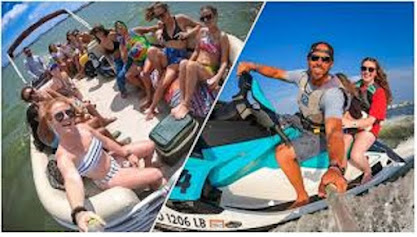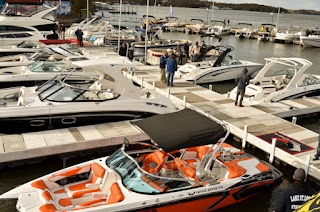Tubing is a exhilarating ride, and can be fun. But also a event that is potentially dangerous and could end with tragic results.
Your kids are more than ready for a fun-filled day tubing on the water. They’re begging you to take them out on the water when the weather’s nice. Your on Vacation, They have been on their best behavior, in the hopes of staying in your good graces. Any parent with a boat and kids are familiar with this scenario.
But do you know how to keep them safe? Tubing accidents and injuries are on the rise. Water tubing, a recreational activity in which participants ride an inner tube which is pulled behind a boat by a tow rope, has grown in popularity in recent years.
According to a new study by researchers at the Center for Injury Research and Policy of The Research Institute at Nationwide Children’s Hospital, the annual number of water tubing-related injuries increased 250 percent over the 19-year study period, rising from 2,068 injuries in 1991 to 7,216 injuries in 2009. Given that more than 83 percent of the injuries occurred during the summer months, this equates to more than 65 water tubing-related injuries being treated in U.S. emergency departments each day during the summer. The study, available online and appearing in the February 2013 print issue of the Journal of Physical Activity & Health, found that the most frequently injured body parts were the head (27 percent) and the upper extremities (24 percent). The most common types of injuries were sprains and strains (27 percent) followed by soft tissue injuries (20 percent). Impact with the water (49 percent) and contact with another water-tubing participant (16 percent) were the most common mechanisms of injury.
Our hope is that these tips might prevent another accident from happening. Of course, a physical activity like tubing is never without its bumps and bruises—those are to be expected once in a while.
As long as you’re navigating the waters safely and minding the kids in the tubes, there should be no reason to experience anything worse than a tumble or two into the water.
Tips for Towing Tubers Behind Your Boat:
1.Injuries can happen while tubing. Usually, it’s nothing to really worry about, especially when everyone involved in the tubing day is properly instructed and wearing the proper safety gear— Life jackets and in some cases helmets, water goggles, proper tow rope, observer, skier down flag and experienced boat operator. Luckily, simple awareness can save the day. It can help you prepare yourself for safe tubing and prevent any serious injuries.
2.Read the manual. Instructions we don't need no stinking instructions. You should always follow your manufacturer instructions.
Before hitting the water, it’s important to check your owner manuals (and tags) for important instructions you might not consider. There may be weight limits, speed limits, specific inflation pressures not to exceed.
3. Be familiar with your riders Lots of folks don’t think about this, but it’s important.
This can help you determine how fast/slow to go, how far to go, how much guidance is needed, if riders need extra protection and how fearful your tubers are.
These are some things you should know before you pull a rider:
- Will it be a multiple or single rider?
- What’s the rider’s knowledge level/experience?
- Is the rider familiar with tubing and tubing equipment?
I won’t tell you what’s right in every situation, but you’ll want to mull these questions over for every individual tuber you pull. With less age and experience—or with more people on the tow line at once—you’ll want to go easier on the speed and turns.Tip: If you’re pulling someone else’s child, it might even be a good idea to get a signed parental release (especially if his/her parents aren’t with you, and/or you don’t know them well).
4. Know your boat. Before tubing, make sure you know how your boat pulls tubers. Since you’re pulling tubes, it’s important to know how your boat reacts. Ask yourself these questions about your boat:
- Does your boat accelerate properly or too fast? Do you have a lead foot, where you’re prone to over-accelerating sometimes?
- Does your boat have trouble pulling more than one rider?
- What’s your boat’s towing capacity?
- How about the weight capacity?
Boat Speed Your boat speed should depend on the rider. The typical speed is between 20 and 25 mph. Your goal should be to make the ride fun and safe for your riders. Going too fast or driving dangerously can turn them off from water tubing.
Checking the manuals in the previous step should’ve helped inform you a little more on these points. Take it for a test drive with need be—or even ask for a more experienced tuber to ride behind you while you get accustomed to towing. Knowing all these things can help you be a better, more responsible driver.
5. Watch the Wakes and No Wake Zones Be responsible and pay attention to wakes. When tubing, the tube easily bounces off wakes; if you’re going too fast, the risk of injury is even higher. So, slow down when crossing wakes (and waves) and don’t put your riders at risk.
Be aware of No Wake Zones. The No Wake Buoys are not suggestions or targets to see how close you can come to. Same with docks, One mishap, one wrong turn can throw a rider into a dock or a buoy and ruin a day. Stay 100 feet away from docks and buoys.
6. Main Channel Do not tube, or ski in the main channel, Here at Lake of the Ozarks at times there can be wakes from 3 to 5 feet. if a rider or skier is down, other boaters may not see them until it is to late. There are many coves, or less traffic area of the lake that are more conducive to tubing.
7. Check the forecast This probably goes without saying for any experienced boats, but you should always check the forecast first. Look for high winds and strong storms, especially lightning storms, as foul weather can put your tubers at risk. You don’t want to have to call it a day before anyone’s even gotten on the tube! Download a few weather apps specifically for boaters.
By equipping your kids, and other tubers, with the proper safety equipment, tubing risks are dramatically reduced. And by following all the other guidelines, you can reduce your risk even more. Now, you can hit the water knowing your kids will be safe tubing!




Comments
Post a Comment